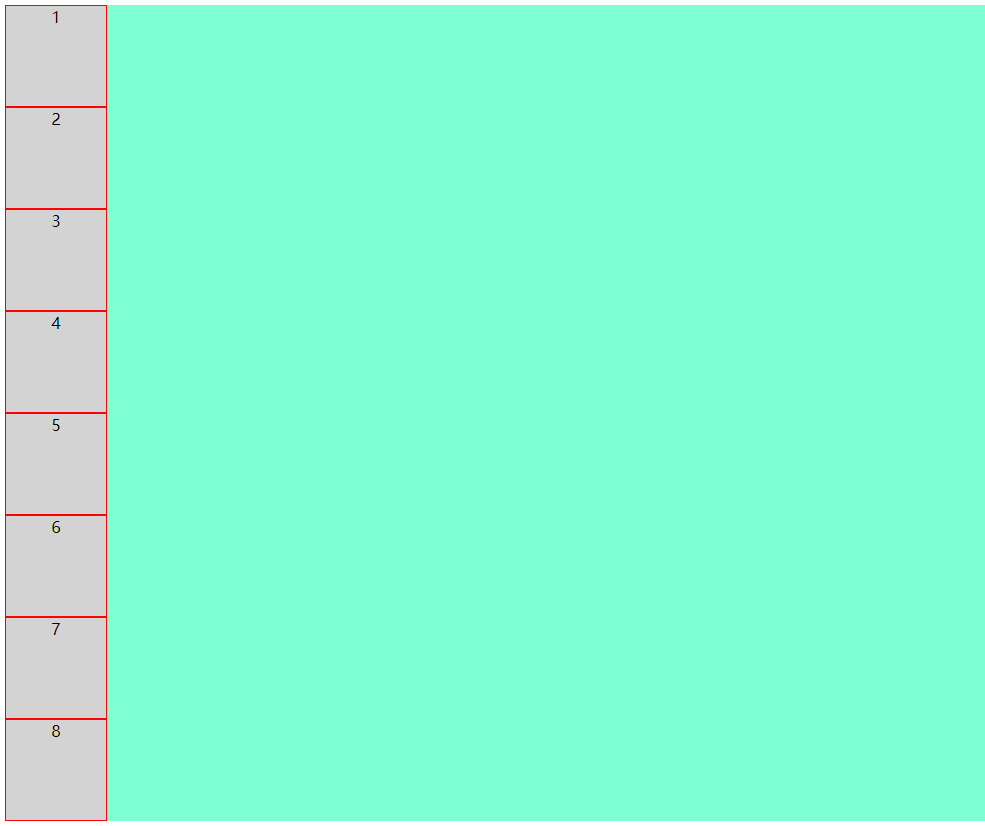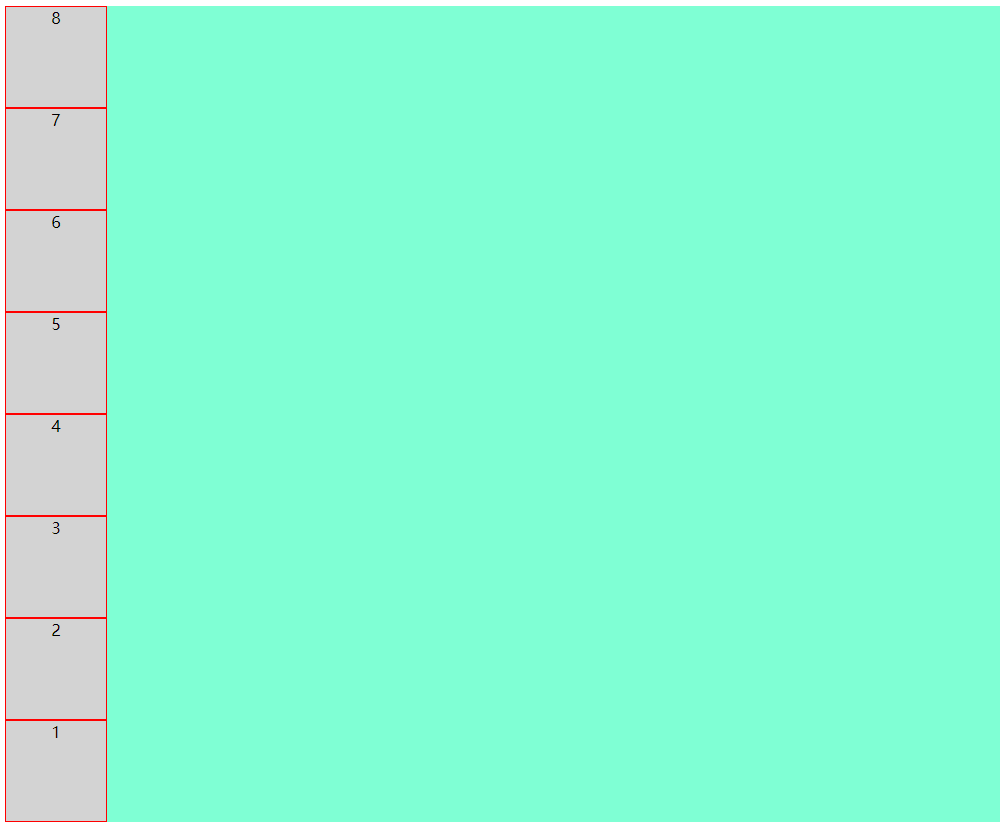前端CSS3布局display:flex用法
前端CSS3布局display:flex用法
先附上代码
点击查看代码
<!DOCTYPE html>
<html>
<head>
<meta charset="utf-8">
<title>display:flex</title>
<style>
.flex-box {
background-color: aquamarine;
}
.flex-box>div {
background-color: lightgray;
width: 100px;
height: 100px;
text-align: center;
border: 1px solid red;
}
</style>
</head>
<body>
<div class="flex-box">
<div>1</div>
<div>2</div>
<div>3</div>
<div>4</div>
<div>5</div>
<div>6</div>
<div>7</div>
<div>8</div>
</div>
</body>
</html>
运行效果

8个小方块呈纵向排列
好,接下来我们看看display:flex到底有哪些好处
先在flex-box中设置display:flex,看看效果
上代码
点击查看代码
.flex-box {
background-color: aquamarine;
display: flex;
}
效果图

仅仅设置了display: flex,8个小方块呈横向排列了
接下来详解flex布局的几个常用属性
flex-direction
flex-wrap
flex-flow
justify-content
align-items
1. flex-direction
该属性决定小方块按横向或纵向排列
(1):row(决定小方块横向排列,起点在左端)
上代码
点击查看代码
.flex-box {
background-color: aquamarine;
display: flex;
flex-direction: row;
}
效果图

可以看到,样式并没有什么变化,这是因为row是flex-direction的默认排列方式
(2):row-reverse(决定小方块横向排列,起点在右端)
上代码
点击查看代码
.flex-box {
background-color: aquamarine;
display: flex;
flex-direction: row-reverse;
}
效果图

(3):column(决定小方块纵向排列,起点在上端)
上代码
点击查看代码
.flex-box {
background-color: aquamarine;
display: flex;
flex-direction: column;
}
效果图

(4):column-reverse(决定小方块纵向排列,起点在下端)
上代码
点击查看代码
.flex-box {
background-color: aquamarine;
display: flex;
flex-direction: column-reverse;
}
效果图

到此,flex-direction属性就讲完了
接下来讲解flex-wrap
2. flex-wrap
该属性决定小方块是否换行,默认不换行,内容会被挤压
(1):nowrap(决定小方块不换行,起点在上端,内容会被挤压)
上代码
点击查看代码
.flex-box {
background-color: aquamarine;
display: flex;
flex-wrap: nowrap;
}
效果图

(2):wrap(决定小方块换行,起点在上端,内容不会被挤压,)
上代码
点击查看代码
.flex-box {
background-color: aquamarine;
display: flex;
flex-wrap: wrap;
}
效果图

(3):wrap-reverse(决定小方块换行,起点在下端,内容不会被挤压,)
上代码
点击查看代码
.flex-box {
background-color: aquamarine;
display: flex;
flex-wrap: wrap-reverse;
}
效果图

3. flex-flow
该属性是用于同时设置 flex-direction 和 flex-wrap 属性的简写属性
包含如下几种可能
row nowrap|wrap|wrap-reverse
row-reverse nowrap|wrap|wrap-reverse
column nowrap|wrap|wrap-reverse
column-reverse nowrap|wrap|wrap-reverse
由于可能太多了,下面只列举了一种,但小编试过了,所有的可能都是对的
(1):row-reverse wrap-reverse(决定小方块呈横向排列且起点在右端,换行且起点在下端,内容不会被挤压)
上代码
点击查看代码
.flex-box {
background-color: aquamarine;
display: flex;
flex-flow: row-reverse wrap-reverse;
}
效果图

4. justify-content
该属性决定小方块在纵轴上的对齐方式
(1):flex-start(决定小方块左对齐)
上代码
点击查看代码
.flex-box {
background-color: aquamarine;
display: flex;
justify-content: flex-start;
}
效果图

(2):center(决定小方块中心对齐)
上代码
点击查看代码
.flex-box {
background-color: aquamarine;
display: flex;
justify-content: center;
}
效果图

(3):flex-end(决定小方块右对齐)
上代码
点击查看代码
.flex-box {
background-color: aquamarine;
display: flex;
justify-content: flex-end;
}
效果图

(4):space-around(决定小方块之间的间隔比小方块与边框的间隔大一倍)
上代码
点击查看代码
.flex-box {
background-color: aquamarine;
display: flex;
justify-content: space-around;
}
效果图

(5):space-between(决定小方块两端对齐,小方块之间间隔相等)
上代码
点击查看代码
.flex-box {
background-color: aquamarine;
display: flex;
justify-content: space-between;
}
效果图

(6):space-evenly(决定小方块之间的间隔相等)
上代码
点击查看代码
.flex-box {
background-color: aquamarine;
display: flex;
justify-content: space-evenly;
}
效果图

5. align-items
该属性决定小方块在横轴上的对齐方式
(1):flex-start(决定小方块上对齐)
上代码
点击查看代码
.flex-box {
background-color: aquamarine;
display: flex;
align-items: flex-start;
}
效果图

(2):center(决定小方块中心对齐)
上代码
点击查看代码
.flex-box {
background-color: aquamarine;
display: flex;
align-items: center;
}
效果图

(3):flex-end(决定小方块下对齐)
上代码
点击查看代码
.flex-box {
background-color: aquamarine;
display: flex;
align-items: flex-end;
}
效果图

(4):baseline(决定小方块第一行文字的基线对齐)
上代码
点击查看代码
.flex-box {
background-color: aquamarine;
display: flex;
align-items: baseline;
}
效果图

(5):stretch(决定小方块占满整个容器的高度)
注意:小方块的高度应不设置或设置为auto
上代码
点击查看代码
.flex-box {
background-color: aquamarine;
display: flex;
align-items: stretch;
}
效果图

以上是容器的属性,接下来我们讲解小方块的属性
order
flex-grow
flex-shrink
flex-basis
flex
align-self
(1):order(决定小方块显示的顺序,默认为0)
注意:小方块order不设置或设置为0的优先级比设置为1的优先级高
注意:该值必须为数字
上代码
点击查看代码
<div class="flex-box">
<div style="order: 1">1</div>
<div style="order: 2">2</div>
<div style="order: 0">3</div>
<div>4</div>
<div>5</div>
<div>6</div>
</div>
效果图

(2):flex-grow(决定某个小方块相对于其它小方块将增长多少)
注意:该值必须为数字,数值越大,增长越多
上代码
点击查看代码
<div class="flex-box">
<div style="flex-grow: 1">1</div>
<div style="flex-grow: 2">2</div>
<div style="flex-grow: 3">3</div>
<div>4</div>
<div>5</div>
<div>6</div>
</div>
效果图

将窗口变长

(3):flex-shrink(决定某个小方块相对于其它小方块将收缩多少)
注意:该值必须为数字,数值越大,收缩越多
上代码
点击查看代码
<div class="flex-box">
<div style="flex-shrink: 1">1</div>
<div style="flex-shrink: 2">2</div>
<div style="flex-shrink: 3">3</div>
<div>4</div>
<div>5</div>
<div>6</div>
</div>
效果图

将窗口缩小

(4):flex-basis(决定某个小方块的初始长度)
上代码
点击查看代码
<div class="flex-box">
<div style="flex-basis: 60px">1</div>
<div style="flex-basis: 80px">2</div>
<div style="flex-basis: 120px">3</div>
<div>4</div>
<div>5</div>
<div>6</div>
</div>
效果图

(5):flex(flex-grow、flex-shrink 和 flex-basis 属性的简写属性)
上代码
点击查看代码
<div class="flex-box">
<div>1</div>
<div>2</div>
<div style="flex: 0 0 200px">3</div>
<div>4</div>
<div>5</div>
<div>6</div>
</div>
效果图

(6):align-self(决定某个小方块的对齐方式,将覆盖容器的 align-items 属性所设置的默认对齐方式)
上代码
点击查看代码
<div class="flex-box">
<div style="align-self: flex-start; height: 60px;">1</div>
<div style="align-self: center; height: 80px;">2</div>
<div style="align-self: flex-end; height: 160px;">3</div>
<div>4</div>
<div>5</div>
<div>6</div>
</div>
效果图

至此,display:flex的常用用法就讲完了
前端CSS3布局display:flex用法的更多相关文章
- 前端CSS3布局display:grid用法
前端CSS3布局display:flex用法 1. 先附上代码 点击查看代码 <!DOCTYPE html> <html> <head> <meta char ...
- CSS弹性盒布局(display:flex)
CSS弹性布局(display:flex) 参考: http://www.runoob.com/w3cnote/flex-grammar.html https://www.jianshu.com/p/ ...
- css3 伸缩布局 display:flex等
<!DOCTYPE html> <html lang="en"> <head> <meta charset="UTF-8&quo ...
- 弹性盒布局display:flex详解
一:弹性盒子 随着响应式设计的流行,网站开发者在设计网页布局时往往要考虑到页面在适配不同分辨率的浏览器时其内部组件位置大小都会产生变化,因此需要设计者根据窗口尺寸来调整布局,从而改变组件的尺寸和位置, ...
- css3布局属性flex
html代码如下: <ul class="ul_box"> <li><a href="#">html</a>&l ...
- css display:flex 属性
一:display:flex 布局 display:flex 是一种布局方式.它即可以应用于容器中,也可以应用于行内元素.是W3C提出的一种新的方案,可以简便.完整.响应式地实现各种页面布局.目前,它 ...
- CSS3:布局display属性的flex(弹性布局)
CSS3:布局display属性的flex(弹性布局) 一.简介 Flex是Flexible Box的缩写,意为"弹性布局",用来为盒状模型提供最大的灵活性.设为Flex布局以后, ...
- 浅谈CSS3中display属性的Flex布局
浅谈CSS3中display属性的Flex布局 最近在学习微信小程序,在设计首页布局的时候,新认识了一种布局方式display:flex 1 .container { 2 display: fle ...
- 【分享】谈CSS3中display属性的flex布局
最近在学习微信小程序(重新学习微信小程序),在设计首页布局的时候,新认识了一种布局方式display:flex .guide-top{ height: 36%; display: flex; /*fl ...
随机推荐
- MyEclipse如何刷新项目
第一种:选中项目,点右键Refresh即可, 第二种:选择project->clean,选中所要编译得项目,点ok即可
- jboss7学习3-jboss安装 访问(外网)添加用户
一.下载安装 1.下载地址: http://www.jboss.org/jbossas/downloads ,下载Certified Java EE 6 Full Profile版本. 2.解压 jb ...
- 截取url传值
// 页面传值 subStr(url) { var obj = {}; var str = url.split('?')[1]; var str2 = str.split('&'); cons ...
- 理解Promise函数中的resolve和reject
看了promise的用法,一直不明白里面的resolve和reject的用法: 运行了这两段代码之后彻底理解了promise的用法: var p = new Promise(function (res ...
- Spring Boot配置druid监控页功能
1.导入坐标 <?xml version="1.0" encoding="UTF-8"?> <project xmlns="http ...
- 攻防世界 favorite_number
favorite_number 进入环境得到源码 <?php //php5.5.9 $stuff = $_POST["stuff"]; $array = ['admin', ...
- Python接入企业微信 - 推送信息到内部群里
前言 之前一篇文章提到了使用wechatpy库来实现企业微信应用登录:Django + Taro 前后端分离项目实现企业微信登录 其实这个库可以实现的功能非常多,基本微信开发涉及到的功能都能实现. 本 ...
- 不仅仅是一把瑞士军刀 —— Apifox的野望和不足
声明:本文内容不涉及任何 Apifox 的功能介绍,一来网上这方面的文章已经汗牛充栋,二来 Apifox 本身的用户体验做的非常好,对于开发者而言学习成本基本为零. 阮一峰:不管你是前端开发还是后端开 ...
- typescript使用入门及react+ts实战
ts介绍 TypeScript是一种由微软开发的自由和开源的编程语言.它是 JavaScript 的一个超集,而且本质上向这个语言添加了可选的静态类型和基于类的面向对象编程. 与js关系 ts与js区 ...
- Redux基础必知必会 reducer拆分 中间件 单向数据流
什么是 redux? 三大原则? 什么是 redux Redux 是一个基于 js 的全局可预测状态容器,主要用于现代前端框架中进行全局状态管理,能够在不同组件之间进行状态共享 Redux 常与 Re ...
